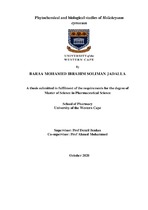| dc.description.abstract | Diabetes mellitus (DM) is well known as a group of systemic metabolic disorders with a considerable mortality rate around the world. Hyperglycemia is the main consequence of DM, which results from the shortage in insulin production or degradation of produced insulin. Other internal and external factors including obesity, oxidative stress, and sedentary lifestyle have been also suggested as the causes of DM. Among the well-known existing types of DM, type 1 and 2 are the most common. Treatment of type 1 necessitates insulin injection, while type II can be controlled by physical exercises, diet control in addition to different synthetic antidiabetic drugs. However, their effectiveness is restricted because of the high cost and unfriendly side effects. There is a significant need for producing alternative and more bioactive antidiabetic drugs from natural sources. Natural products are a well-known source for the discovery of new scaffold for drugs discovery, and South Africa is one of the most important megaflora with a high percentage of endemism. South Africa is home to about 245 species of Helichrysum species, which are generally rich sources of secondary metabolites, especially flavonoids, which give them a great value for global acceptability and wide application in the pharmaceutical fields as antibacterial, anti-inflammatory, antioxidant, and antidiabetic agents. The phytochemical investigation of the methanolic extract of H. cymosum resulted in the isolation and identification of seven pure compounds (1-7). Structural characterization of these isolated compounds was conducted using 1D NMR, in comparison with reported spectroscopic data. The in vitro bio-evaluation of H. cymosum against alpha-glucosidase shown that 5 exhibited the highest alpha-glucosidase inhibitory activity with IC50 value of 13 μM, followed by 7 and 3 with IC50 values of 18.16 μM and 44.4 μM respectively. Additionally, strong total antioxidant capacities were displayed by 6 and 2 as ORAC (122.86 ± 0.7 and 91.70 ± 0.4 μM TE/mL) respectively as well as 5 and 7 as FRAP (1006.34 ± 1.7; 977.79 ± 0.8) μM AAE/g. This is the first scientific report to be carried out on alpha-glucosidase inhibitory activities and antioxidant capacities of H. cymosum constituents. The findings suggest that these compounds might become prominent natural candidates to inhibit alpha-glucosidase as well as oxidative stress related to diabetes with the prospect to be employed in the formulation of diabetes drugs upon further biological studies. | en_US |

